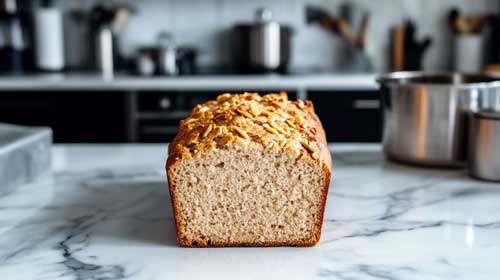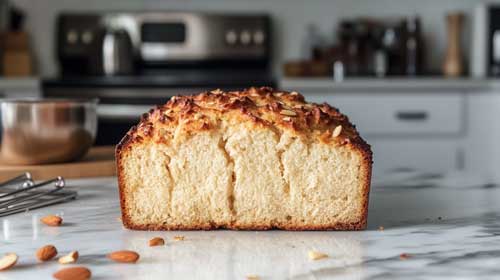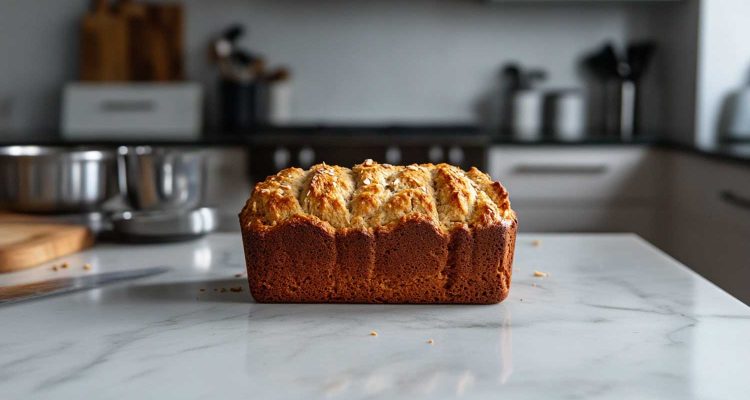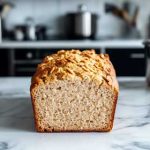Are you on a ketogenic diet and missing the comforting taste of bread? You’re not alone.
Bread is often one of the most missed foods for those following a low-carb lifestyle.
Fortunately, keto almond flour bread offers a delicious and nutritious alternative that will satisfy your cravings without kicking you out of ketosis.
In this article, we’ll dive into everything you need to know about keto almond flour bread, including its benefits, how to make it, and tips for perfecting the recipe.
What is Keto Almond Flour Bread?
Keto almond flour bread is a low-carb, gluten-free alternative to traditional wheat bread. It’s made primarily from almond flour, which is a popular choice for those on a ketogenic diet due to its low carbohydrate content. This bread is perfect for making sandwiches, toast, or enjoying as a snack with some butter. Unlike typical bread that is high in carbs and spikes your blood sugar, keto almond flour bread is designed to be both delicious and suitable for a low-carb diet.
Why Choose Almond Flour?
Almond flour is a favorite among keto dieters for several reasons:
- Low in Carbs: Almond flour contains only about 2 grams of net carbs per 1/4 cup serving, making it ideal for maintaining ketosis.
- Rich in Nutrients: It is packed with healthy fats, protein, and fiber, which are essential for a balanced keto diet.
- Gluten-Free: Almond flour is naturally gluten-free, making it suitable for those with gluten intolerance or celiac disease.
- Versatile and Delicious: It has a slightly sweet, nutty flavor that works well in both savory and sweet recipes.
Nutritional Benefits of Keto Almond Flour Bread
One of the biggest advantages of keto almond flour bread is its impressive nutritional profile. Here’s what you get in one slice of this low-carb bread:
- Calories: 180
- Fat: 15 grams
- Protein: 6 grams
- Net Carbs: 2 grams
- Fiber: 3 grams
In addition to being low in carbs, keto almond flour bread is also rich in healthy fats, which are crucial for sustaining energy levels on a ketogenic diet. The high protein content helps keep you full longer, making it easier to stick to your dietary goals.
Essential Ingredients for Keto Almond Flour Bread

To make the perfect keto almond flour bread, you’ll need the following ingredients:
- Almond Flour: The star of the recipe. Make sure to use finely ground, blanched almond flour for the best texture.
- Eggs: These provide structure and help the bread rise.
- Baking Powder: This helps give the bread its fluffy texture.
- Butter or Coconut Oil: Adds moisture and richness to the bread.
- Psyllium Husk Powder: Optional but recommended for added fiber and improved texture.
- Apple Cider Vinegar: This reacts with the baking powder to help the bread rise.
- Salt: For flavor.
How to Make the Best Keto Almond Flour Bread
This is the full, extra-careful, no-shortcuts guide to baking perfect keto bread with almond flour — fluffy, moist (but not soggy), easy to slice, and with zero eggy taste.
Ingredient Checklist
Dry Ingredients:
- 2 cups almond flour
- Use super-fine blanched almond flour, NOT almond meal.
- Why it matters: Almond meal is grainy and includes skins. Your bread will be gritty and heavy.
- Brands like Bob’s Red Mill (the “super-fine” one) or Kirkland (Costco) work great.
- 1 teaspoon baking powder
- Must be fresh (test: if it fizzes when mixed with vinegar, you’re good).
- Do NOT use baking soda — that’s a different beast.
- 1 tablespoon psyllium husk powder (optional but highly recommended)
- Use the powdered form, not whole husks.
- Why? It absorbs moisture, gives structure, improves texture and crumb.
- If you skip it: your bread might be flatter and more fragile.
- 1/4 teaspoon salt
- Table salt is fine. Sea salt or pink salt also works.
Wet Ingredients:
- 4 large eggs
- Let them sit at room temperature for at least 30 minutes before using.
- Cold eggs = your fat will clump up, and batter won’t mix right.
- Crack into a separate bowl first to avoid shell bits.
- 2 tablespoons of melted butter or coconut oil
- If using coconut oil: use refined if you don’t want a coconut taste.
- MUST BE COOLED BEFORE MIXING — hot oil will cook the eggs.
- 1 teaspoon apple cider vinegar
- Works with the baking powder to give the bread a proper rise.
- No, it won’t make the bread taste sour.
Equipment You’ll Need (Don’t Skip These)
- Standard 9×5 inch loaf pan (not mini, not oversized)
- 2 mixing bowls (1 large, 1 medium)
- Whisk or fork
- Rubber spatula or large spoon
- Measuring cups & spoons (level the almond flour!)
- Parchment paper or non-stick spray
- Wire rack for cooling (do NOT cool in the pan)
- Oven thermometer (optional, but helps catch incorrect oven temps)
Making Of Bread
1) Preheat Oven First
- Set oven to 350°F (175°C). Always preheat before mixing anything.
- If your oven tends to run hot or cold, use an oven thermometer to verify.
- Position the oven rack in the center — not too high or low.
2) Prepare Your Loaf Pan
Choose one method:
- Grease method: Rub the inside of the pan with butter or coconut oil using a paper towel. Get the corners and edges too.
- Parchment paper method (recommended):
- Cut a piece of parchment so it fits the bottom of the pan and hangs over the two long sides (for easy lifting later).
- Lightly grease the parchment too so nothing sticks.
Don’t skip pan prep. This bread can stick like glue if you do.
3) Mix Dry Ingredients Thoroughly
In your large mixing bowl, whisk together:
- 2 cups almond flour
- 1 teaspoon baking powder
- 1 tablespoon psyllium husk powder (if using)
- 1/4 teaspoon salt
Important:
- Break up all clumps, almond flour tends to clump.
- Mix at least 30 seconds to evenly distribute everything.
- If you see clumps of psyllium or baking powder later, it’s too late.
4) Whisk Wet Ingredients
In your medium bowl, combine:
- 4 eggs
- 2 tablespoons melted and cooled butter or coconut oil
- 1 teaspoon apple cider vinegar
How to do it:
- Whisk eggs first, until yolks and whites are completely blended.
- Then add the melted fat and vinegar. Whisk until smooth and slightly frothy.
- The mixture should look golden and uniform — no oily film on top.
5) Combine Wet and Dry Ingredients
- Slowly pour the wet mix into the dry mix bowl.
- Use a rubber spatula or large spoon to gently stir. Don’t beat it.
- Scrape sides and bottom of the bowl to make sure no dry pockets remain.
What the batter should look like:
- Thick but spreadable.
- Not pourable like cake batter — closer to peanut butter.
- If it looks too thin, let it sit for 2–3 minutes. Psyllium will thicken it up.
6) Transfer Batter to Loaf Pan
- Spoon batter into your prepared loaf pan.
- Use the spatula to press it down and smooth out the top.
- Make sure it’s level — an uneven surface can bake lopsided.
Optional:
- Lightly wet your spatula with water to prevent sticking while smoothing.
- Sprinkle sesame or flax seeds on top if you like a crusty finish.
7) Bake
- Put the pan in the center rack of the preheated oven.
- Bake at 350°F (175°C) for 30 to 40 minutes.
How to tell it’s done:
- Top should be golden brown.
- Toothpick inserted in center should come out clean or with just a crumb or two.
- If it comes out wet, keep baking in 5-minute intervals and check again.
💡 If the top starts browning too quickly, tent with foil (gently lay it over the top) around the 25-minute mark.
8) Cooling – DO NOT RUSH
- Remove from oven. Let it sit in the pan for exactly 10 minutes.
- Then, using the parchment paper or a butter knife, lift or gently loosen the bread from the sides.
- Transfer to a wire rack to cool fully — at least 40 minutes before slicing.
Why wait?
- Cutting too early = gummy, undercooked texture.
- Cooling firms up the bread and helps flavors settle.
Slicing:
- Use a serrated knife (bread knife).
- Light, gentle sawing motion. Don’t press down hard or it’ll squish.
Storing:
- Wrap tightly in plastic wrap or place in airtight container.
- Store at room temp for 2 days, fridge for up to 1 week.
- To freeze: Slice first, then place parchment between slices and freeze in a zip-top bag for up to 2 months.
Reheating:
- Toast slices in a dry skillet or toaster.
- Avoid microwaving unless you like rubbery bread.
Made A Mistake?
| Problem | Likely Cause | Fix |
| Bread didn’t rise | Old baking powder, skipped vinegar, oven wasn’t hot | Use fresh baking powder, preheat oven |
| Eggy taste | Used medium eggs or didn’t mix well | Use large eggs, whisk thoroughly |
| Too dense | Overmixed or skipped psyllium | Mix gently, include psyllium |
| Crumbly texture | Overbaked or cut too soon | Bake just until done, cool completely |
| Stuck to pan | Didn’t grease or line pan | Always grease or use parchment |
Tips for Perfecting Your Keto Bread

- Room Temperature Ingredients: Make sure your eggs and butter are at room temperature. This helps the ingredients combine more easily, resulting in a smoother batter.
- Avoid Overmixing: Once the wet and dry ingredients are combined, avoid overmixing, as this can make the bread too dense.
- Psyllium Husk for Better Texture: While optional, adding psyllium husk powder can improve the texture and structure of the bread, making it more similar to traditional bread.
- Watch the Baking Time: Ovens vary, so keep an eye on the bread towards the end of the baking time to avoid overbaking.
Storage and Freezing Instructions
Keto almond flour bread stores well, making it perfect for meal prep. Here’s how to store it:
- Room Temperature: Store in an airtight container or wrap in plastic wrap for up to 3 days.
- Refrigeration: If you prefer to keep it longer, refrigerate the bread for up to 7 days. Just ensure it’s wrapped well to prevent it from drying out.
- Freezing: Keto almond flour bread freezes beautifully. Slice the bread, then wrap each slice in plastic wrap and store in a freezer-safe bag. This way, you can grab a slice whenever you need it. It will keep in the freezer for up to 3 months.
Conclusion
Keto almond flour bread is a game-changer for anyone on a low-carb diet. It’s easy to make, incredibly versatile, and offers the familiar comfort of bread without the carbs. Whether you’re new to keto or a seasoned pro, this recipe is sure to become a staple in your kitchen. With the tips and instructions provided, you’ll be able to bake the perfect loaf every time. Enjoy your bread toasted, as a sandwich base, or simply on its own with a slather of butter. Happy baking!
PrintKeto Almond Flour Bread Recipe
Soft, sliceable keto almond flour bread that bakes up golden, slightly nutty, and not at all eggy. Perfect for sandwiches, toast, or a quick low-carb snack. This recipe is super detailed to help avoid common mistakes like soggy middles or overly dense texture. Beginner-friendly and made with pantry staples.
- Prep Time: 10 minutes
- Cook Time: 35 minutes
- Total Time: 40 minutes
- Yield: 1 loaf (12 slices) 1x
- Category: Bread
- Method: Baking
- Cuisine: American, Keto, Low-Carb
- Diet: Gluten Free
Ingredients
-
2 cups super-fine blanched almond flour (not almond meal)
-
4 large eggs, room temperature
-
2 tablespoons melted butter or refined coconut oil (cooled)
-
1 teaspoon baking powder (fresh)
-
1 tablespoon psyllium husk powder (optional but recommended)
-
1 teaspoon apple cider vinegar
-
1/4 teaspoon salt
Instructions
-
Preheat the Oven to 350°F (175°C). Position the oven rack in the middle.
-
Prepare the Pan: Grease a 9×5-inch loaf pan or line with parchment paper.
-
Mix Dry Ingredients: In a large bowl, whisk together almond flour, baking powder, psyllium husk powder (if using), and salt. Mix well to remove clumps.
-
Whisk Wet Ingredients: In a separate bowl, whisk eggs until uniform, then add melted (and cooled) butter or oil and apple cider vinegar. Whisk until smooth.
-
Combine Wet and Dry: Slowly mix the wet ingredients into the dry ingredients using a rubber spatula. Stir until a thick, sticky batter forms. Don’t overmix.
-
Transfer to Pan: Spoon batter into the prepared pan. Smooth the top with a wet spatula for an even surface.
-
Bake: Bake for 30–40 minutes. Start checking at 30 minutes. A toothpick inserted into the center should come out clean or with just a few crumbs.
-
Cool Properly: Let the bread cool in the pan for 10 minutes, then transfer to a wire rack to cool completely — at least 40 minutes — before slicing.
Notes
-
Use only blanched almond flour, not almond meal — it affects the texture.
-
Room temp eggs help the batter mix better and rise more evenly.
-
Let the melted butter or coconut oil cool before mixing or it will cook the eggs.
-
Psyllium husk powder improves texture but is optional. If using whole psyllium husk, triple the amount and blend it to a powder first.
-
Don’t skip cooling — cutting too early makes the bread fall apart.
-
Best knife for slicing: bread knife or serrated knife.
-
Store covered at room temp for 2 days, fridge for 1 week, or freeze sliced.
Nutrition
- Serving Size: 1 slice
- Calories: 165 Sugar: 0.7g Sodium: 134mg Fat: 14g Saturated Fat: 4.2g Unsaturated Fat: 9g Trans Fat: 0g Carbohydrates: 4g Fiber: 2g Protein: 6g Cholesterol: 62mg
Frequently Asked Questions (FAQs)
Can I substitute almond flour with another flour?
Almond flour is the key ingredient in this recipe, so substituting it with another flour will change the texture and carb content. Coconut flour, for example, is much more absorbent, so you would need to adjust the recipe significantly.
Why did my bread turn out dense?
Keto bread tends to be denser than traditional bread due to the lack of gluten. However, overmixing the batter or not using enough leavening agents like baking powder can also contribute to a denser texture.
Can I add flavors to the bread?
Absolutely! You can add herbs, garlic, or even cheese to the batter for a savory twist, or sweeten it with a keto-friendly sweetener for a more dessert-like bread.

